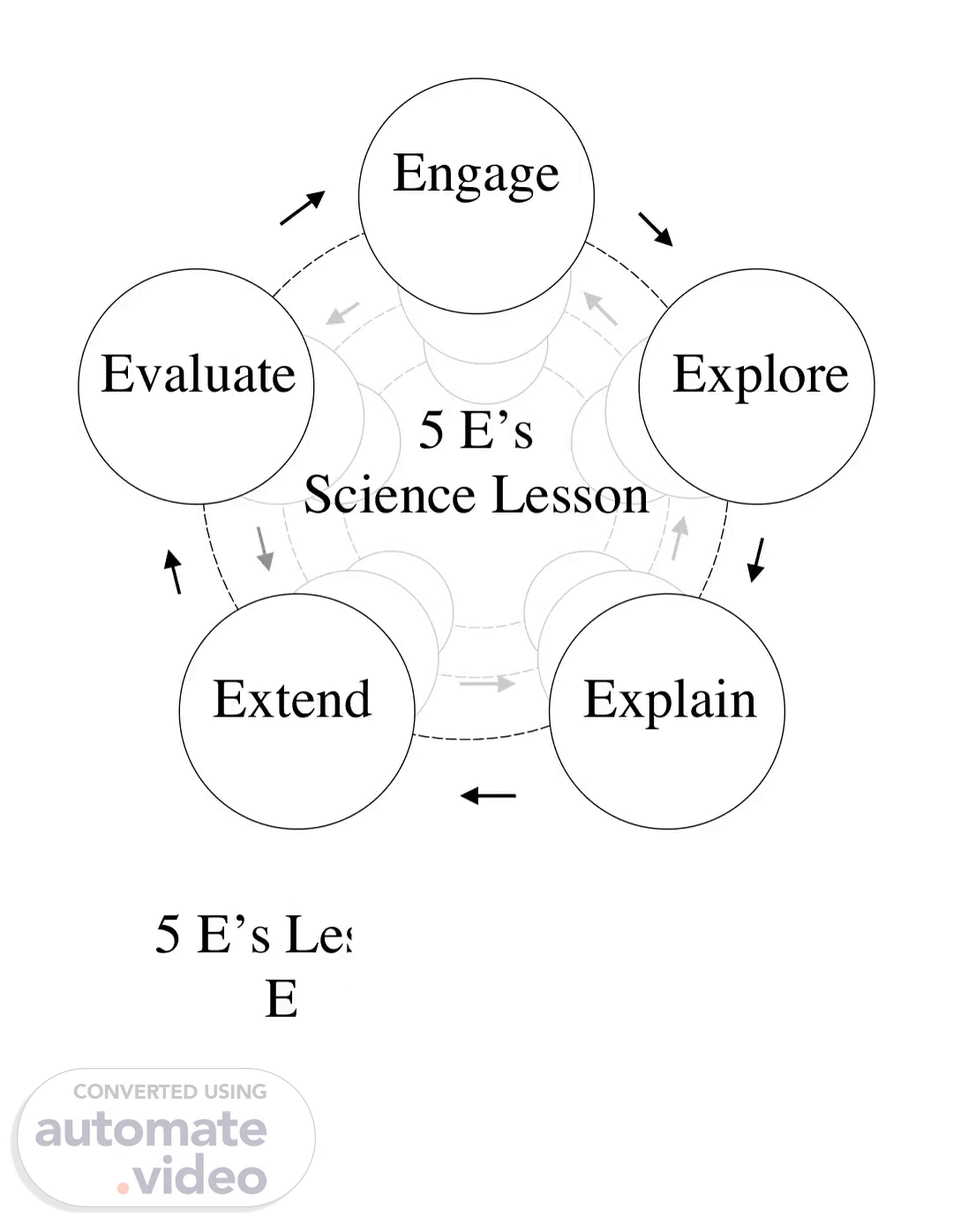
Page 1 (0s)
. . Engage. Explore. Explain Extend. Evaluate. 5 E’s.
Page 2 (11s)
. . engage g Evaluate c:' Qleldö. Engage: In most instances you will want to begin with Engage. In this stage you want to create interest and generate curiosity in the topic of study; raise questions and elicit responses from students that will give you an idea of what they already know. This is also a good opportunity for you to identify misconceptions in students' understanding. During this stage students should be asking questions (Why did this happen? How can I find out?) Examples of engaging activities include the use of children's literature and discrepant events..
Page 3 (1m 20s)
. . The 5E Model of Instruction. . The first phase is to engage the student in the learning task. The student.
Page 4 (2m 36s)
. . . Explanation means the act or process in which concepts, processes, or.
Page 5 (3m 52s)
. . At some point, it is important that students receive feedback on the.
Page 6 (4m 33s)
. 5 E’s Suggested Activity What the Teacher Does What the Student Does Engage • Demonstration • Reading • Free Write • Analyze a Graphic Organizer • KWL • Brainstorming • Creates interest. • Generates curiosity. • Raises questions. Elicits responses that uncover what the students know or think about the concept/topic • Asks Questions such as, Why did this happen? What do I already know about this? What can I find out about this? • Show interest in the topic. Explore • Perform and Investigation • Read Authentic Resources to Collect Information • Solve a Problem • Construct a Model • Encourages the students to work together without direct instruction from the teacher. • Observes and listens to the students as they interact. • Asks probing questions to redirect the students’ investigations when necessary. • Provides time for students to puzzle through problems. • Thinks freely but within the limits of the activity. • Tests predictions and hypotheses. • Forms new predictions and hypotheses. • Tries alternatives and discusses them with others. • Records observations and ideas. • Suspends judgment. Explain • Student Analysis & Explanation • Supporting Ideas with Evidence • Structured Questioning • Reading and Discussion • Teacher Explanation • Thinking Skill Activities: compare, classify, error analysis • Encourages the students to explain concepts and definitions in their own words. • Asks for justification (evidence) and clarification from students. • Formally provides definitions, explanations, and new labels. • Uses students’ previous experiences as basis for explaining concepts. • Explains possible solutions or answers to others. • Listens officially to others’ explanations. • Questions others’ explanations. • Listens to and tries to comprehend explanations the teacher offers. • Refers to previous activities. • Uses recorded observations in explanations. Extend • Problem Solving • Decision Making • Experimental Inquiry Think Skill Activities: compare, classify, apply • Expects the students to use formal labels, definitions, and explanations provided previously. • Encourages the students to apply or extend the concepts and skills in new situations. • Reminds the students to existing data and evidence and asks, What do you already know? Why do you think…? • Strategies from Explore apply here also. • Applies new labels, definitions, explanations, and skills in new, but similar situations. • Uses previous information to ask questions, propose solutions, make decisions, and design experiments. • Draws reasonable conclusions from evidence. • Records observations and explanations. • Checks for understandings among peers. Evaluate • Any of the Above • Develop a Scoring Tool or Rubric • Test (SR, BCR, ECR) • Performance Assessment • Produce a Product • Journal Entry • Portfolio • Observes the students as they apply new concepts and skills. • Assesses student’s knowledge and/or skills. • Looks for evidence that the students have changed their thinking or behaviors. • Allows students to assess their own learning and group-process skills. • Asks open-ended questions, such as: Why do you think..? What evidence do you have? What do you know about x? How would you explain x? • Answers open-ended questions by using observations, evidence, and previously accepted explanations. • Demonstrates an understanding or knowledge of the concept or skill. • Evaluates his or her own progress and knowledge. • Asks related questions that would encourage future investigations. 5 E’s Activities.
Page 7 (5m 38s)
. . The 5 E’s Lesson Organizer. ENGAGE :. ENGAGE:.
Page 8 (5m 48s)
. . Elementary Science Lesson Planning Sheet. Grade: Unit:.
Page 9 (6m 19s)
. . Montgomery County Public Schools Science Office 8/01.
Page 10 (7m 12s)
. . Montgomery County Public Schools Science Office 8/01.